 |
 |
 |
| |
Efficacy and Safety of Peginterferon Alfa-2a/Ribavirin in Methadone Maintenance Patients:
Randomized Comparison of Direct Observed Therapy and Self-Administration
|
| |
| |
Reported by Jules Levin
Presented at the 2007 Digestive Disease Week (DDW) Meeting, May 19-24, 2007, Washington, DC.
This study was supported by Roche Laboratories.
Herbert L. Bonkovsky1; Alan D. Tice2; Rockford G. Yapp3; Henry C. Bodenheimer, Jr4; Alexander Monto5; Stephen J. Rossi6; and Mark S. Sulkowski7
1University of Connecticut Health Center, Farmington, Connecticut; 2University of Hawaii, Honolulu, Hawaii; 3Good Samaritan Hospital, Downers Grove, Illinois; 4Beth Israel Medical Center, New York, New York; 5Veterans Affairs Medical Center, San Francisco, California; 6Roche Laboratories, Nutley, New Jersey; 7Johns Hopkins University, Baltimore,
Introduction
Injection drug users constitute the largest group of people in the United States infected with hepatitis C virus (HCV), and injection drug use is one of the strongest risk factors for HCV infection.1 Conversely, an estimated 80% to 95% of injection drug users have been infected with HCV and approximately 80% are chronic HCV carriers2,3
Injection drug users motivated to enter methadone maintenance programs can be open to treatment of chronic hepatitis C (CHC),4 and studies have shown that individuals in methadone maintenance programs can be successfully treated for CHC5,6
HCV-infected patients who are injection drug users and have comorbid psychiatric illnesses and conditions may be more compliant with therapy with careful monitoring and aggressive intervention, including direct observed therapy (DOT), especially if drug and CHC treatment are integrated7
To determine whether this is true, patients in methadone maintenance programs were randomized into a DOT arm and a self-administration (SA) arm for administration of peginterferon alfa-2a, with ribavirin self-administered in both arms. The primary purpose was to determine if patients completed therapy that included defined stopping rules for nonresponse at Week 12. The secondary purpose of this study was to determine whether treatment with peginterferon alfa-2a and ribavirin was effective and safe in these patients.
Conclusions
Patients in methadone maintenance programs can be treated safely and successfully with peginterferon alfa-2a plus ribavirin for CHC while continuing methadone treatment
Overall SVR rates and rates of patient dropout, discontinuance, and dose
adjustments similar to other studies in methadone maintenance patients5,6
The DOT group had a higher SVR rate than the SA group
The DOT group also had lower postbaseline BDI-II scores than the SA group
- Occurrence of higher SVR and lower postbaseline BDI-II score in the DOT group (may or may not indicate correlation)
- Need to conduct trials in larger numbers of patients
Treatment with peginterferon alfa-2a once weekly, at the methadone maintenance clinic, is an efficient way to administer both medications at the same time.
Patients and MET HODS
Key Inclusion Criteria
Males or females aged ≥18 years infected with HCV genotypes 1, 2, or 3 and not
previously treated for CHC
HCV RNA >600 IU/mL by the HCV QuantaSure Plus (TaqMan) test 30 days prior to first dose
Enrollment in methadone maintenance program with documented attendance for
≥3 months prior to study enrollment
Agreement to abstain from alcohol and illicit drug use during treatment and follow-up
Total score <29 on the Beck Depression Inventory-Second Edition (BDI-II)8
Key Exclusion Criteria
Seropositivity for antihepatitis A virus IgM Ab, hepatitis B surface antigen,
antihepatitis B core protein IgM, or anti-HIV Ab
Indications of metabolic liver disease or renal disease
History of severe psychiatric disease, including major depression
BDI-II total score ≥29, score greater than 0 on Question 9 (suicidal thoughts or
wishes), or score of 20 to 28 without documented psychiatric evaluation
Treatments
DOT arm -- patients seen each week at the methadone clinic
-- Patients had to agree to come to the methadone clinic once weekly for 24 or 48 weeks for their injection of peginterferon alfa-2a plus once weekly for 24 weeks of treatment-free follow-up
SA arm -- patients seen per study schedule of assessments, only at the investigative site
-- Patients had to agree to be willing to follow protocol-required study visits for
24 or 48 weeks plus 24 weeks of treatment-free follow-up
Standard treatment regimens for CHC
-- Genotype 1 -- peginterferon alfa-2a (180 _g/week) plus ribavirin (1000 or 1200 mg/day) for 48 weeks, plus 24 weeks of treatment-free follow-up
-- Genotypes 2 and 3 -- peginterferon alfa-2a (180 _g/week) plus ribavirin (800 mg/day) for 24 weeks, plus 24 weeks of treatment-free follow-up
Assessments
HCV RNA >600 IU/mL by the HCV QuantaSure Plus (TaqMan) test 30 days prior to first dose
-- Genotype 1 -- at screening; baseline; Weeks 4, 12, 24, and 48 during treatment; and at Weeks 60 and 72 during follow-up
-- Genotypes 2 and 3 - at screening; baseline; Weeks 4, 12, and 24 during
treatment; and at Weeks 36 and 48 during follow-up
BDI-II - questionnaire used to assess a patient's degree of depression8
-- Total score measures level of depression; higher score correlates with more
severe depression
-- At screening; Weeks 2, 4, 6, 8, 10, and 12; and every 4 weeks thereafter to
Week 48 (genotypes 2 and 3) or Week 72 (for genotype 1)
Hepatitis Quality of Life Questionnaire (HQLQ) - measures quality of life (QOL)
improvements associated with treatment of CHC9
-- Includes the 8 individual QOL scales of the SF-36, 2 generic scales, and
2 hepatitis-specific scales
-- Measured at screening, end of treatment, and end of follow-up
Results
Patient disposition is shown in Figure 1
Figure 1. There were 24 patients in DOT arm & 24 in SA arm: 8 discontinuations in DOT (safety reasons 2, nonsafety reasons 6); 12 discontinuations in SA (3 safety reasons, 9 nonsagety reasons, including 1 who failed to return during followup). 16 completed treatment in DOT & 12 completed treatment in SA and had 24 week followup. 24 patients in each group were part of the ITT and safety population analyses.
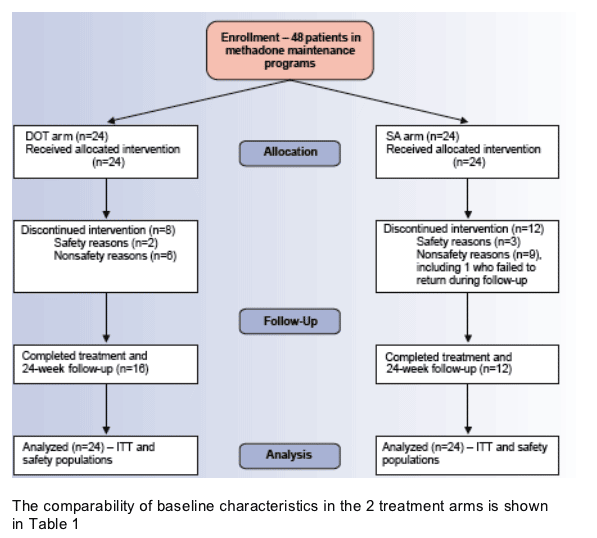
The comparability of baseline characteristics in the 2 treatment arms is shown
in Table 1
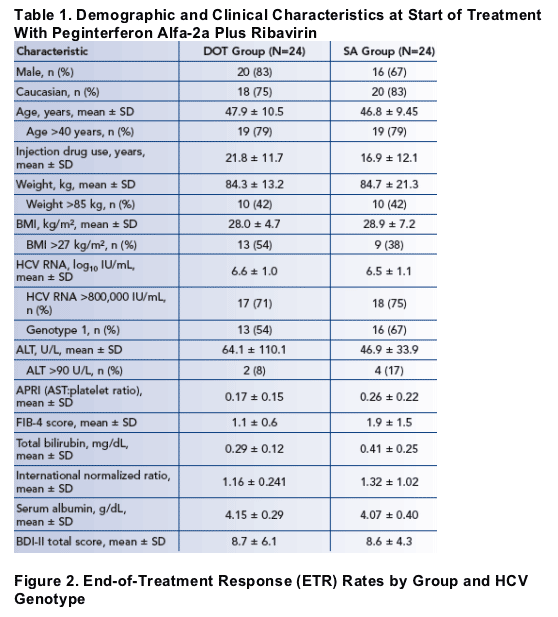
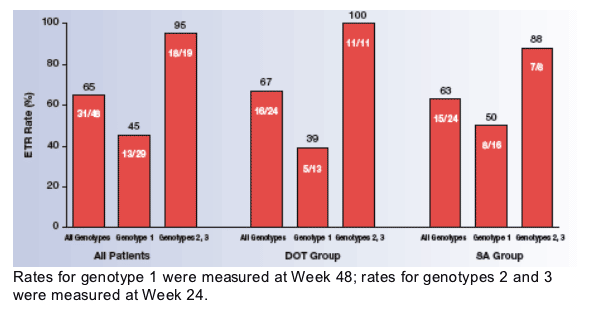
Figure 3. Sustained Virologic Response (SVR) Rates by Group and Genotype
Overall responses were 54% SVR in DOT group vs 33% SVR in SA group, but among genotype 1 SVR was 23% in DOT & 38% in SA. Among genotype 2/3 SVR was 91% in DOT vs 25% in SA.
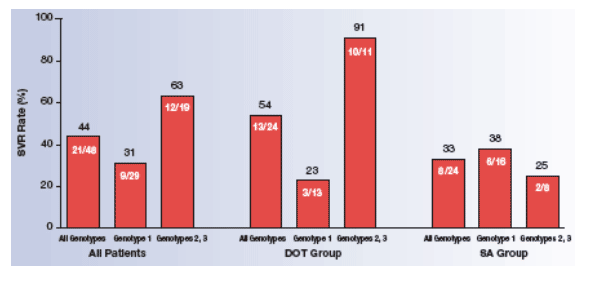
Univariate analysis showed that genotype 1 (P=.032) and non-Caucasian race
(P=.037) were predictors of failure to achieve SVR and ALT >90 U/L (P=.066) was of borderline significance; treatment (SA vs DOT), gender, and baseline [HCV RNA] were not.
Stepwise logistic regression analysis, using as factors treatment (SA vs DOT),
gender, age (≦40 vs >40 years), genotype (1 vs 2 and 3), race (Caucasian vs other), baseline [HCV RNA] (≦800,000 vs >800,000 IU/mL), and ALT (≦90 vs >90 U/L), showed that DOT (odds ratio [OR] 4.3, 95% CI 1.06-17.3, P=.042) and Caucasian race (OR 10.8, 95% CI 1.13-104, P=.039) were significant predictors of SVR.
Treatment Completion
Based on defined efficacy stopping rules, 37/48 (77%) patients completed the
prescribed length of time
Psychiatric Responses - BDI-II Scores
Table 2 shows BDI-II total scores and BDI-II classifications throughout the trial
-- The DOT and SA groups were well matched for mean BDI-II scores and BDI-II
classification at baseline
-- Highest postbaseline scores of minimal depression were more frequent in the
DOT than in the SA group (67% vs 38%)
-- Highest postbaseline scores of moderate depression were less frequent in the
DOT than in the SA group (21% vs 46%)
-- Highest postbaseline scores of severe depression were equivalent in the
2 groups
-- At end of treatment and end of follow-up, mean BDI-II scores were higher
in the SA group
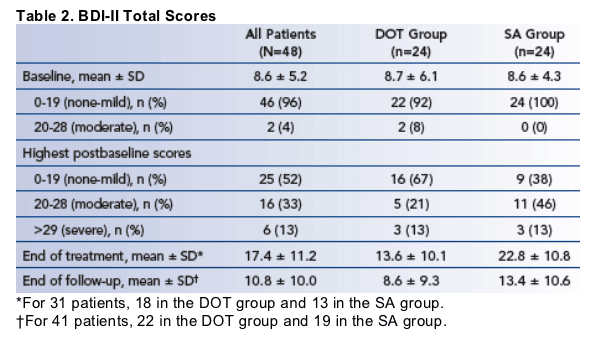
Psychiatric Responses - HQLQ
Mean ± SE HQLQ domain scores were determined at baseline, end of treatment,
and end of follow-up
-- Generally, QOL parameters in both groups declined from baseline to end of
treatment but recovered by end of follow-up
-- No clear differences between the DOT and SA groups were discernible
Withdrawals and Dose Adjustments
2 DOT and 3 SA patients were withdrawn for adverse events (AEs)
-- 6 DOT and 9 SA patients were withdrawn for nonsafety reasons
4 DOT and 5 SA patients required dose adjustments of peginterferon alfa-2a for AEs or laboratory abnormalities
-- 2 DOT and 5 SA for AEs
-- 2 DOT and 0 SA for laboratory abnormalities
12 DOT and 9 SA patients required dose adjustments of ribavirin for AEs or
laboratory abnormalities
-- 8 DOT and 9 SA for AEs
-- 5 DOT and 1 SA for laboratory abnormalities
References
1. Armstrong GL, Wasley A, Simard EP, McQuillan GM, Kuhnert WL, Alter MJ. The prevalence of hepatitis C virus infection in the United States, 1999 through 2002. Ann Intern Med. 2006;144:705-714.
2. Thomas DL, Vlahov D, Solomon L, et al. Correlates of hepatitis C virus infections among injection drug users. Medicine (Baltimore). 1995;74:212-220.
3. Des Jarlais DC, Schuchat A. Hepatitis C among drug users: déjà vu all over again? Am J Public Health. 2001;91:21-22.
4. Stein MD, Maksad J, Clarke J. Hepatitis C disease among injection drug users: knowledge, perceived risk and willingness to receive treatment. Drug Alcohol Depend. 2001;61:211-215.
5. Mauss S, Berger F, Goelz J, Jacob B, Schmutz G. A prospective controlled study of interferon-based therapy of chronic hepatitis C in patients on methadone maintenance. Hepatology. 2004;40:120-124.
6. Sylvestre DL, Litwin AH, Clements BJ, Gourevitch MN. The impact of barriers to hepatitis C virus treatment in recovering heroin users maintained on methadone. J Subst Abuse Treat. 2005;29:159-165.
7. Weisner C, Mertens J, Parthasarathy S, Moore C, Lu Y. Integrating primary medical care with addiction treatment: a randomized controlled trial. JAMA. 2001;286:1715-1723.
8. Beck AT, Steer RA, Brown GK. Beck Depression Inventory-II (BDI-II). 2nd ed. San Antonio, Tex: Harcourt Assessment; 1996.
9. Bayliss MS, Gandek B, Bungay KM, Sugano D, Hsu M-A, Ware JE Jr. A questionnaire to assess the generic and disease-specific health outcomes of patients with chronic hepatitis C. Qual Life Res. 1998;7:39-55.
|
| |
|
 |
 |
|
|